May 1, 2009
Air Date: May 1, 2009
FULL SHOW
SEGMENTS
Italian-American Fuel Efficiency
View the page for this story
As Chrysler reorganizes in bankruptcy, it also seals a partnership with Italian car-maker Fiat. LA Times automotive columnist Dan Neil talks with host Steve Curwood about what the new partnership will mean for greening the Chrysler fleet and what the future may holds for other U.S. auto companies. (05:00)
Green Report Card
View the page for this story
The Obama administration has hit the ground running on clean energy, climate change and other environmental matters. Living on Earth reviews the administration's major acts. And we'll hear from the president's top environmental advisor, Nancy Sutley. (06:30)
Farming the Flu
View the page for this story
As health officials try to guess where the so-called swine flu will show up next, other researchers are trying to track the H1N1 virus to its origins. And a number of experts suspect large-scale factory farms. Host Jeff Young talks with Johns Hopkins Public Health Professor Ellen Silbergeld who says crowded, filthy conditions at factory farms could speed the mutation and transfer of viruses from pigs to people. (06:35)
There Will Be Flood
View the page for this story
New Orleans residents have been waiting for the official word on why the levees failed in the aftermath of Hurricane Katrina and have been hoping for assurance that they won’t fail again. What they got was a dense report from the Army Corps of Engineers. Host Steve Curwood asks David Moreau from the National Academies of Science to help make sense of the recent government report. The bottom line: people in flood prone areas will get wet. (06:30)
Leave it to Beaver
View the page for this story
Pablo Picasso once said creativity is a sum of destructions. Salt Marsh Diary writer Mark Lender observes that nature is a sum of creations and destructions, as exemplified in the American Beaver. (03:30)
Note on Emerging Science
/ Liz GrossView the page for this story
Researchers find naturally occurring laughing gas in clam bellies. But as Liz Gross reports the impact on the climate is not so funny. ()
The Floating World
View the page for this story
In 1990, Nike sneakers mysteriously washed up all along the Pacific Coast. These floating shoes were the beginning of a life’s work for oceanographer Curtis Ebbesmeyer. He has spent the years since then tracking everything from sneakers to rubber ducks that float on the ocean’s surface – and learning the deeper workings of the seas in the process. Ebbesmeyer joins host Jeff Young to talk about his new book, "Flotsametrics and the Floating World." (07:35)
Retiring the Wrist Watch
View the page for this story
Once upon a time, there were wristwatches but their time has come and gone. Cellphones have made watches passé but, as Living on Earth's Bruce Gellerman reports, The Thousand Watch Project hopes to preserve them...for all time. (07:25)
Show Credits and Funders
Show Transcript
Host: Steve Curwood and Jeff Young
Guests: David Moreau, Dan Neil, Ellen Silbergeld, Nancy Sutley,
Reporters: Bruce Gellerman
Commentator: Mark Seth Lender
Note: Liz Gross
[THEME]
CURWOOD: From Public Radio International - this is Living on Earth.
[THEME]
CURWOOD: I’m Steve Curwood.
YOUNG: And I’m Jeff Young.
As the threat of pandemic flu stalks the globe – scientists say huge factory farms offer ideal conditions to incubate dangerous new diseases.
SILBERGELD: You have thousands of animals held in close confinement under conditions that are not sanitary – and therefore, you have a lot of hosts available to exchange a pathogen which is one of the processes by which viruses and bacteria evolve.
CURWOOD: Plus – how the Chrysler bankruptcy could pave the way to a greener auto industry.
And – we’ll hear how the clock is running out on one way of telling time.
MOSKOW: If you think about it, most people under the age of 25 don’t wear a wristwatch- they use their cell phone. So arguably the wristwatch will go the same way as a pocket watch.
YOUNG: That - and more - this week on Living on Earth! Stick around.
[NEWSBREAK MUSIC: Boards Of Canada “Zoetrope” from “In A Beautiful Place Out In The Country” (Warp Records 2000)]
Italian-American Fuel Efficiency

The new Fiat 500 could be the first Fiat built in North America.
ANNOUNCER: Support for Living on Earth comes from the National Science Foundation and Stonyfield Farm.
[THEME]
CURWOOD: From the Jennifer and Ted Stanley studios in Somerville, Massachusetts, this is Living on Earth. I’m Steve Curwood.
YOUNG: And I’m Jeff Young in Washington.
President Obama came into office pledging to save jobs and create millions of new green ones. And now he could be doing both by putting the public treasury behind a bankruptcy reorganization of Chrysler Motors.
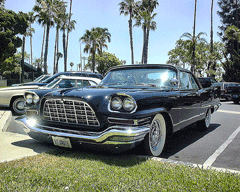
Chrysler’s 300C of 1957, an ancestor of the muscle car. Chrysler was one of the first car companies in the United States. (Photo: Matthew Brown)
OBAMA: It’s a partnership that will give Chrysler not only a chance to survive but to thrive in a global auto industry. Fiat has demonstrated that it can build the clean fuel-efficient cars that are the future of this industry. And as part of this agreement, Fiat has already agreed to transfer billions of dollars in cutting edge technology to Chrysler to help them do the same. Fiat has also committed to working with Chrysler to build new fuel-efficient cars and engines right here in America.
CURWOOD: This is a no-money-down deal for Fiat, but Fiat must keep at least 90 percent of Chrysler’s workforce. The deal could also be a model for how the government might use tax dollars to rescue GM.
Dan Neil, automotive writer for the Los Angeles Times, joins us. Now, Dan, you’re in California, that’s a state that’s on track to limit global warming gases from cars, and other states are set to follow suit. Now, how is that key to the Chrysler Fiat business plan?
NEIL: Well that requirement would raise the emission standards for autos in California up to thirty or forty percent by 2016, which is a dramatic increase in efficiency for automobiles. In that case – yes, Chrysler would be far better positioned, assuming it can survive long enough to rebadge and otherwise reengineer these Fiat platforms that are intended to remodel the show rooms of Chrysler.
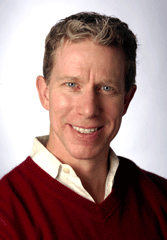
Dan Neil is an automotive columnist for the LA Times.
CURWOOD: Next up is General Motors, GM, they’ve got another few weeks to work out a deal, but it looks like at the end of the day that company will be thirty percent owned by the union. How green will GM become?
NEIL: Well, a lot depends on, I think - the California ruling will make a big difference in product planning going forward. If they want to stay in business they’ll have to meet these higher standards, obviously. So they will be at least that green. One of the ironies of this whole process is that they’re having to sell off some of the very things that they’re going to need to survive. For example, they’re going to get rid of Opel. Well, Opel makes really great small cars with really great precision engines. They’re gonna have to get rid of Saab. They’re gonna get rid of Saturn. Saturn really helps GM’s CAFE bottom line. And then, of course, there’s the Volt which is a range extended battery electric hybrid that GM has been building and sort of trumpeting for a couple of years now. The Volt will be a money loser for quite a while after it comes to market. They want to sell it for $40,000. It probably costs $80,000 to build. So, that’s also not a source of profitability in the short term. It’s going to be very, very difficult for GM to become greener and at the same time become, as they say, a viable business entity.
CURWOOD: You say that GM is gonna loose money on the Volt. Well Toyota, of course, lost a lot of money on the Prius. It cost them about $60,000 or $80,000 to make the first Priuses and they were selling it in the thirties, they were losing a lot of money.
NEIL: Right.
CURWOOD: What is it that the federal government needs to be prepared to do if its gonna see GM and Chrysler and perhaps even have to help Ford through this transition to greener vehicles.
NEIL: Well, the big thing they could do is to stabilize the price of gasoline. That would be a big help. The next thing they could do is they could help with battery technology, which, in fact, the Obama administration has done. They put over $2 billion into advanced battery technology for automobiles. The third thing they could do – they have done – is they are finally offering some clarity on carbon emissions from automobiles. You know, one of the things that was so frustrating watching this process in the past decade is that the car companies were fighting against these regulations, but they really suffered from the uncertainty.

The Fiat 500 with its retro look could be the first Fiat built in North America.
NEIL: Ah well, the ultimate villain in all of this is the quarterly profit report. Japanese companies take a much longer view of things. The Prius was a long-term investment. Same deal with Honda. Honda invested in hybrid technology long before it was cool, long before it was profitable. This constant near term thinking and planning led General Motors for example in 2006 to double down on SUVs and big truck design. And that left them, when the crisis came, at a disadvantage because when people stopped buying these trucks and SUVs in great numbers, their sales fell through the floor.
CURWOOD: What are the odds that GM and Chrysler can catch up with Honda and Toyota in their quality?
NEIL: The world will have to turn over on its axis before that happens. It’s going to be a very big challenge. Now when we’re talking about vastly smaller, vastly leaner, vastly more agile companies than General Motors, Chrysler or Ford – yeah, there’s no reason. There are actually more smart people in Detroit than there are in the car business in Tokyo. It is a mistake to think that American carmakers are somehow inherently inferior. They’re not. They’ve been hamstrung by a system and a corporate culture. This bankruptcy, this purifying fire, that these companies may be going through now – I think will unleash a great deal of innovation and they will rise again. But it will be very challenging in the short term.
CURWOOD: So, perhaps in the future you’ll be buying – what will we call it – a Fi-ysler or a Chri-at?
NEIL: I like that. You better trademark those. Those are good.
CURWOOD: Dan Neil is an automotive columnist for the Los Angeles Times. Dan - thanks so much.
NEIL: Okay. You’re welcome, Steve.
Related links:
- For Dan Neil’s reviews of some Fiat models, click here.
- For a quixotic road test video of the Fiat 500 Abarth done by the folks at Top Gear in the UK, click here.
Green Report Card
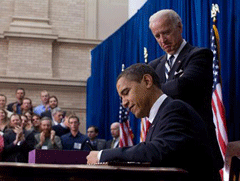
President Obama signing the American Recovery and Reinvestment Act, directing nearly $80 billion to clean energy, the environment and science. (Photo by Pete Souza, Courtesy of the White House)
YOUNG: The auto industry’s just one area where President Obama has tried to steer energy, the environment and the economy together during his first hundred days in office. To get an idea of what’s happened in those hundred days, consider just one day: Monday, April 27th:
On that day, the Environmental Protection Agency indicated it will toughen rules on pollution from power plants. The Interior Department reversed rules that let mountaintop removal coal mines dump waste near streams. And Obama’s Secretary of State said the US was ready to lead the way to a global warming agreement.
All in just one day--and a Monday at that.
This president who stressed “the fierce urgency of now” on the campaign trail has wasted no time. His first major legislative achievement, the economic stimulus package, put tens of billions of dollars toward clean energy. Obama told workers at an Iowa wind turbine facility that he’s made more progress in three months than the country has seen in three decades.
OBAMA: We're beginning to break the bonds, the grip, that fossil fuels has on us. We're beginning to create a new, clean-energy economy -- and the millions of jobs that will flow from it.
CURWOOD: President Obama assembled an environmental team that has won high praise from the scientific community. And Team Obama has overturned Bush-era decisions on energy, endangered species and land management. President Obama’s Interior Secretary, Ken Salazar, put the Republican plan for offshore drilling on hold and revoked some controversial drilling permits.
SALAZAR: We revisited the decision to offer areas in Utah near Arches and Canyonland National Parks for oil and gas drilling and I’m proud of that decision.
YOUNG: But despite this early burst of activity, there are still doubts about whether the course the administration is setting will meet the tremendous challenges.
I sat down with Nancy Sutley to talk about that. As chair of the White House Council on Environmental Quality, she’s the president’s top environmental policy adviser. Sutley says she’s pleased with the administration’s early progress.

Nancy Sutley.
YOUNG: Let’s talk about the clean energy investment and the green jobs creation. Is it mostly the potential for green jobs creation or is the stimulus money actually getting out quickly enough were you have concrete examples you can point to – here are green jobs.
SUTLEY: Well, I think there’s a broad spectrum of things that come under green jobs, but the American Recovery and Reinvestment Act really does have money going out the door quickly to fund some programs that we know work, things like low income weatherization, things like investing in research and development for things like smart grid that’s already going out the door. Those investments are green jobs.
YOUNG: On climate change, I gotta say, here we are 100 days and you haven’t solved global warming yet.
SUTLEY: Well, yeah, give us a few more days, but you know – I think we’ve made a lot of progress. The Recover Act gives us a good template to work from and those funds, you know, really is to grow this sector of the economy, but also to really address the peril that global warming is putting our planet into. The U.S. was sort of missing in action for the last eight years, so things like the President showing leadership at the international level, the State Department is hosting this major economies forum, it’s a way to get to the largest economies of the world who also happen to be the largest greenhouse gas emitters talking to each other in anticipation of Copenhagen. So there’s been a lot going on in climate change.

President Obama signs the stimulus bill into law, directing nearly $80 billion to clean energy, the environment and science. (Photo by Pete Souza, the White House)
SUTLEY: I think the American people are hopeful and optimistic about the ability to run our economy more sustainably, to create millions of jobs that can’t be exported overseas. We’re running the risk of falling behind on things like manufacturing renewable energy products and so I think there’s a sense of hopefulness that this new green economy and that this investment in clean energy will produce real benefits for the American economy, and I think people understand that.
YOUNG: That’s Nancy Sutley, chair of the White House Council on Environmental Quality. You can hear the entire interview at our website, loe.org.
[MUSIC: Bill Laswell “Beyond The Zero” from Dub Chamber 3 (Universal Songs Of Polygram Intl 2000)]
CURWOOD: A warming planet, two wars and a weak economy—this president has his hands full. And now we add to that list the threat of pandemic flu. Just ahead, we explore the possible links between the flu virus and factory farming.
Keep listening to Living on Earth.
Related links:
- Hear all of Jeff Young’s interview with Nancy Sutley.
- For more on the Obama administration’s green side, check out LOE’s interview with EPA administrator Lisa Jackson…
- … our profile of Lisa Jackson….
- ... our profile of Labor Secretary Hilda Solis….
- … our analysis of the President’s science team …
- And our story on Secretary of State Hilary Clinton visit to China
[CUTAWAY MUSIC: Spyro Gyra “Unspoken” from Down The Wire (Heads Up 2009)]
Farming the Flu

The H1N1 2009 virus has a mix of genetic material linked to pigs, birds, and humans.
CURWOOD: It’s Living on Earth, I’m Steve Curwood.
YOUNG: And I’m Jeff Young.
World health authorities are on alert, tracking the new flu – now officially called the H1N1 2009 flu. Not as catchy as swine flu maybe, but more accurate since scientists are still working to better understand the connection between the virus and pigs. While heath officials are trying to check the virus’s spread, other researchers working to find its origin. And some of them suspect large-scale factory farms may have played a role.
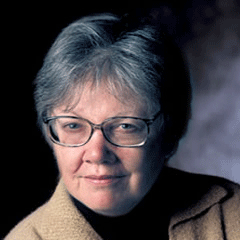
Ellen Silbergeld.
SILBERGELD: The aspects of this strain that are troubling to us are, number one: that it has clearly moved from non-human into human hosts. Number two: that it appears to readily infect one human from another human, so its transmissible among us, you don’t have to have contact with pigs or birds to get this virus. And third: that it is quite virulent, that is, it causes serious illness.
YOUNG: Now why do we suspect pigs had some role here and what is it that is special about pigs that makes them a possible conduit for a flu that humans can get?
SILBERGELD: The reason why this is notable is of course that pigs are very close to humans in terms of the immune system. And so an influenza virus that has been able to infect pigs is in some way closer to being conditioned to infecting us.
YOUNG: Why do you suspect these large-scale farms? What is it about this particular method of farming that you think makes it easier for viruses to change and to jump from species to species?
SILBERGELD: Well, this, of course, is not strictly limited to influenza viruses, but is based on observations by us and others in studying bacteria as well as viruses.
These operations contain elements that really are conducive to raising concerns for public health. You have thousands of animals, in the case of pigs usually between two and six thousand animals, held in close confinement under conditions that are not sanitary, that is frankly that they’re housed with their wastes. And therefore you’ve got a lot of hosts available to exchange a pathogen, which is one of the processes by which viruses and bacteria evolve and acquire mutations. And then the way in which these operations are run – and I want to stress that this is a worldwide issue, it is not peculiar or restricted to Mexico.
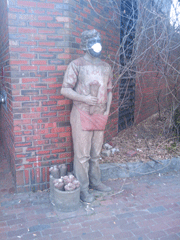
The spread of the flu has everyone worried. (Photo: Bruce Gellerman)
YOUNG: So despite their efforts to keep it secure, you can’t stop the flow of air, you can’t stop insects.
SILBERGELD: Well, the issue is most of the bio-security practices that have been developed by the industry – most of them have been to protect the animals from a person bringing in a disease that could be dangerous to the health of the animals. In terms of what we call bio-containment – that is preventing from something that might be in the house from coming out – there’s very, very imperfect and limited protection.
YOUNG: Is there evidence that the people who work at these type farms are more susceptible to catching diseases from the animals and able to spread disease to other people.
SILBERGELD: There’s considerable evidence that workers in these operations, farmers and farm workers are in fact at greater risk of exposure. Studies conducted in Iowa and other places have demonstrated that workers in swine CAFOs have a high rate of infection by swine influenzas. In the same way that we and others have reported that workers in poultry houses have a high rate of being infected by poultry born pathogens. Now – and here’s one of the tricky things – they may not be sick. I’m sure you’ve heard of Typhoid Mary – and the really worrying thing in public health is what we call the asymptomatic carrier, that is a person who’s become infected by a pathogen but does not get sick.

The H1N1 2009 virus has a mix of genetic material linked to pigs, birds, and humans.
SILBERGELD: They are one bridge. But I do want to emphasize these environmental pathways of dispersion through air and waste that may be even more important.
YOUNG: And what would be your recommendations, how could this type of farming be made less likely to produce dangerous diseases?
SILBERGELD: I think in light of this event, there are some things we should do in the short term. First and foremost, we need to recognize the critical role of industrial food animal production in the emergence of new diseases. And we need to direct much more oversight and monitoring as to what’s going on in terms of what’s happening in the animals and also in people who are really at the front line, who are the workers and the farmers and the nearby communities. These groups really aren’t part of our monitoring and surveillance programs at the same time. Second, I think we need to immediately institute much better oversight over the management of waste. Influenzas can survive in wastes for months. And yet there are no requirements for either testing or appropriate management. And this has got to be a very important switch point in this whole process globally speaking.
YOUNG: Ellen Silbergeld is professor of environmental health at Johns Hopkins Bloomberg School of Public Health. Thanks very much for your time.
SILBERGELD: Thank you.
[MUSIC: Tosca “Chocolate Elvis (Boozoo Baju Soul Sufferer Version) from Chocolate Elvis Dubs (G-Stone records 1999)]
Related link:
For more on Ellen Silbergeld, click here.
There Will Be Flood
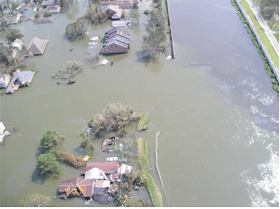
The 17th Street Canal Breach. (Photo: IPET)
CURWOOD: As if the young Obama Administration didn’t have enough to contend with, it also inherited the problems of New Orleans and Louisiana in the wake of Hurricane Katrina. Much of Gulf region still faces dire threats from flooding should another storm strike.
Shortly after Katrina, Ivor van Heerden, the deputy director of the Louisiana State University Hurricane Center was among those who urged authorities to rethink the levee system. He suggested that their protected areas should be scaled back, but also made stronger where they protect core areas including downtown New Orleans.
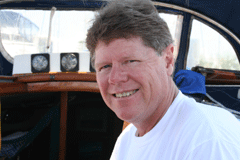
Ivor Van Heerden
CURWOOD: How many people right now live outside the protected system you're talking about?
VAN HEERDEN: It probably amounts to maybe 100,000 at the most. The bottom line in all of this is as you plan it has to be a case of not what's good for me, but what's good for the most folk, what’s good for everybody, what makes the best sense for the overall population in coastal Louisiana.
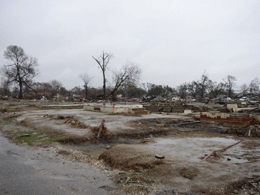
The Lower Ninth Ward in January 2006, about five months after Katrina. (Photo: David Moreau)
The interagency task force, known by its acronym IPET also found fault with some of the Army Corps’ engineering practices. University of North Carolina professor David Moreau was part of the National Academy review.
MOREAU: The report is remarkably candid in several places. Particularly candid in terms of its assessment of the failure along the 17th street canal which led to the flooding of a major portion of the central city. So there’s nothing being papered over there. Whether it’s this report or the general information about what happened during Katrina, there will be a very significant change in the design of protective facilities. There will be a substantial change in how the risk is communicated. The committee recommended that in fact the IPET staff actually hire a firm that specializes in communicating with the public to take the findings and translate those into common, everyday language.
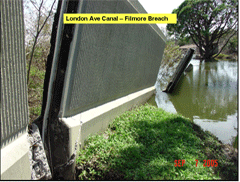
(Photo: IPET).
MOREAU: The 100 year return year period is an average return period. But there’s a very substantial likelihood that that during a thirty-year mortgage that if you in fact knew exactly what the likelihood was it would be around 25, 27 percent.
CURWOOD: So, wait a second – if I were told that over the life of say owning a house it had a 27 percent chance of getting flooded out, that doesn’t seem like acceptable odds.
MOREAU: It’s not. For a place like New Orleans, it’s totally unacceptable. The real message is if you live in areas that are below sea level – you’re at risk. And you should exercise caution, should be prepared for failures if they occur.
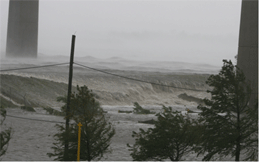
Overtopping along Gulf Intracoastal Waterways. (Photo: IPET)
MOREAU: Well, the suggestion is impractical if you put it in terms of prohibition. What you could do, and should do, in my opinion, is to avoid building facilities that give people a false sense of security. That we’re talking here in a report addresses the fact that there are 350 miles of protective structures around New Orleans. I’m not sure the language that we used, but I’ll say it’s a virtual impossibility to ensure that all 350 miles of that system are going to be fully functional a hundred percent of the time.
CURWOOD: In other words, in certain areas say, there is no effective flood protection here – be here at your own risk.
MOREAU: That’s right.
CURWOOD: Well, at this point we know that the cost of the Katrina floods is at some place north of $80 billion.
MOREAU: Right.
CURWOOD: So, if we had spent $80 billion on flood protection at least it would have provided jobs and people wouldn’t have died and lost so much ground, and social and emotional, as well as financial capital.
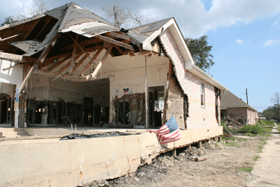
A home trashed by the 17th Street Canal breach.
CURWOOD: And for 80 billion bucks, do you think we could protect New Orleans?
MOREAU: For 80 billion bucks you could do a lot of other things that might be a lot more beneficial than rebuilding levees or making them higher. You might be able to relocate people. You might be able to create jobs in areas that are substantially at less risk. It requires some additional analysis that has not yet been publicly released.
CURWOOD: Professor David Moreau, thank you so much.
MOREAU: Thank you, Steve.
Related links:
- For more on David Moreau, click here.
- Check out the Living on Earth series on Lousiana storm protection.
[MUSIC: John Scofield “That’s Enough” from Piety Street (Emarcy Records 2009)]
Leave it to Beaver
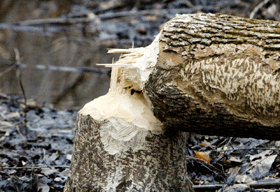
A beaver takes a tree. (Photo: Mark Seth Lender ©)
YOUNG: People aren’t alone in their desire to change the places where water and land come together. Writer Mark Seth Lender spent some time watching one of nature’s engineers at work.
LENDER: The pond is still as polished stone, a duotone, tannic brown and gray. And quiet. A quiet made of fine rain. Slow churning of earthworm. Purr of woodpecker on a dead tree across to the other shore. Hush of river rolling over the dam of crossed sticks, which holds all this, this space, this wetted openness.
Toward me now comes the Engineer. Fast as a blur he comes, the V of his wake deep and sure, nose lifted just above the water. Thick fur, wet but warm, covers him all but where he sees and breathes and hears, and the pad of his paw. He has no gills, no fins, no scales. When he dives he holds his breath. Where water flows he must stop it. Wherever it goes he will find it. He is drawn by the sound and by the feel and perhaps, even the scent. Now closer, as close to me as curiosity demands, ‘til the flat of his tail waves goodbye and smooth as a silk scarf he disappears, under water.

(Photo: Mark Seth Lender ©)
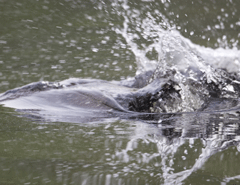
(Photo: Mark Seth Lender ©)
Taming of the liquid force is the lifework of the American Beaver. It is the product of both forethought and design and an agile mind. First, a survey must be made. Noting where the bank is high and the river narrow he will begin there. He needs no protractor. No T square. Lacking transit and plumb bob he proceeds by rack of eye alone yet what he builds endures. With saplings and small lumber, in a weave that seems random but is not, with mud, with stones, layer by layer the dam is raised until all water will be conquered.
In the finishing of a pond a beaver takes many trees. Teeth are his adze and ax and he works in the round. Carefully. His lodge laid of branches is the keep where his family shelters, and their safety is his purpose. High in the leafy tops, predators may lurk in the form of eagles. Low down, cougar and coyote may hide behind the trunks. To hold the standing woods at a distance is not unwise in a beaver’s nearsighted eyes.
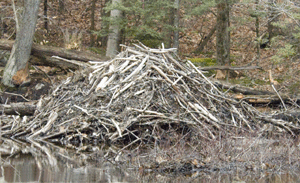
(Photo: Mark Seth Lender ©)
All this is here from what the beaver clears. Much depends upon the Engineer.
[MUSIC: Andrew Bird “Natural Disaster” from Noble Beast (Wegawam Music 2009)]
YOUNG: Mark Seth Lender writes a syndicated column called “Salt Marsh Diary.” To see some of his photographs, go to our website at LOE.org.
Just ahead – the time has come to find a home for abandoned wristwatches. Stay with us - on Living on Earth.
ANNOUNCER: Support for the Environmental Health Desk at Living on Earth comes from the Cedar Tree Foundation. Support also comes from the Richard and Rhoda Goldman fund for coverage of population and the environment. And from Gilman Ordway for coverage of conservation and environmental change. This is Living on Earth on PRI, Public Radio International.
[CUTAWAY MUSIC Jack DeJohnette: “Equipoise” from The DeJohnette Complex (Columbia 1971)]
Related link:
Salt Marsh Diary
Note on Emerging Science
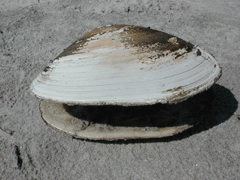
“Excuse me!”
YOUNG: It’s Living on Earth. I’m Jeff Young
CURWOOD: And I’m Steve Curwood.
Just ahead – the strange things that ride the tide – but first, we head under the surf for this note on emerging science from Liz Gross.
[EMERGING SCIENCE THEME]
GROSS: Laughing gas can make a dental patient happy as a clam. But scientists were not so happy to find clams belching out this powerful greenhouse gas.
[THEME]
GROSS: A recent study by Danish and German biologists analyzed digestion in a number of aquatic bottom feeders, including mollusks and insect larvae. The belly gas of these invertebrates contained levels of laughing gas – or nitrous oxide – that surprised the scientists.
Nitrous oxide is the fourth largest contributor to global warming. Pound for pound, this gas traps 310 times as much heat as carbon dioxide. While burning fossil fuels is the most common source of nitrous oxide emissions, worms living in nitrogen-rich soil also release the gas. The recent study though was the first to measure the emissions from animals living in rivers, streams and oceans.
But the researchers found it’s not the clams themselves that release the gas - it’s their lunch. These animals feed on sediment full of nitrogen-hungry bacteria.

“Excuse me!”
With demand for nitrogen fertilizer increasing, and global greenhouse gas emissions going up, nitrous oxide in mollusk burps is no laughing matter.
That’s this week’s note on emerging science. I’m Liz Gross.
The Floating World
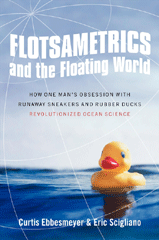
YOUNG: Well it’s nearly time for many of us to plan a trip to the beach—maybe dig some of those clams, as we catch some rays, or do a bit of beachcombing.
Oceanographer Curtis Ebbesmeyer has turned beachcombing into a lifetime scientific pursuit. From Nike shoes to rubber duckies – to the proverbial message in a bottle – he’s studied the stuff that floats on the sea. And it’s led him to a deeper understanding of how our oceans really work.
Ebbesmeyer’s just written a book called “Flotsametrics and the Floating World” – and he joins us now from Seattle – welcome to Living on Earth!
EBBERMEYER: It’s a pleasure, Jeff. Thank you for having me.
YOUNG: How did you get started in this? Why follow floating junk on the ocean?
EBBERMEYER: Well, I started by following slabs of water back in the 60s and following currents in the water is like chasing ghosts, you can’t really see them except with electronical things and instruments. And then in about 1990 my mom pointed out all these Nike sneakers washing on the ocean and she said, “isn’t that what you do?” I’ve never looked back.
YOUNG: So tell me about the sneakers that went over board – how did that happen anyway?
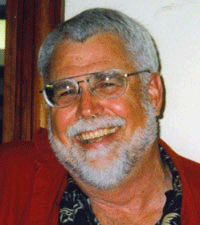
Curtis Ebbesmeyer.
YOUNG: But they had to find the other one, right?
EBBESMEYER: So they were having swap meets up and down the coast, exactly.
YOUNG: To match the left with the right?
EBBERMEYER: Exactly.
[LAUGHING]
EBBESMEYER: A friend of my Steve McLeod had been making matches and he was selling them for $30 a pair, a matched pair and he had records of 1600. And it turned out that each Nike shoe and an individual number, which I could trace like a message in a bottle. So I learned where they went, where they fell overboard and I learned where they washed up out of the ocean.
YOUNG: So, from there you’ve really kind of tapped in to beachcombers, scavengers as your first wave of scientists, of data collectors.
EBBESMEYER: Exactly, there’s armies of beachcombers out there every day collecting things and they until now had been outside of science, so I guess it’d be like archeologists ignoring the people who find potshards in the fields.
YOUNG: You know something I love about the Nike sneaker story is so many of them washed up really close to the Nike headquarters. It was almost like they were salmon returning to the ancestral spawning ground or something.
[LAUGHING]
EBBESMEYER: I tried to point that out to Nike but they said – I said don’t you want to use this for some kind of advertising value. They said quote “floating on the ocean is not a sports attribute that we wish to endorse.”
[LAUGHING]
YOUNG: Right
EBBESMEYER: Unquote.
YOUNG: Another big spill of cargo that you found especially intriguing – it was these rubber duckies.
EBBESMEYER: Yeah, that was in the 1990s, about every year or two they’d be a cargo container or so go over board with some really interesting flotsam. 1990 was the year of the Nike sneakers. 1992 was the year of the bathtub toys. One cargo container that went overboard held 29,000 turtles, ducks, beavers, and frogs. And I learned point A and beachcombers were reporting all kinds of points B around Sitka.
YOUNG: Sitka, in Alaska.
EBBESMEYER: Correct.
YOUNG: And why did they go there?
EBBESMEYER: They wrote the southern edge of the Aleut gyre. It’s that great circle of currents. It runs from Sitka over to Kamchatka down to Japan and back to Sitka again. It’s about an 8,000-mile circuit. And it takes about three years to go around and every time the toys would do around that gyre one orbit, you’d see more of them at Sitka. And it’s just almost like clockwork. Quite amazing. So I learned that that gyre was a three-year orbital period and I started collecting flotsam for the ten other gyres in the planet. And they have this wonderful sequence in octaves – thirteen years, six years, three years, and one and a half years. So the ocean has this grand musical scale, which I’m still in awe of.
YOUNG: What importance have these gyres had for humans?
EBBESMEYER: They’ve actually influenced the course of history in remarkable ways that hasn’t heretofore been appreciated. Columbus saw flotsam in the Azores, which he thought was remarkably fresh and reported that to the Queen, saying that land can’t be too far to the west. So flotsam had a significant bearing on Columbus going to the Americas. The Vikings knew where things collected. Their God Thor told them – commanded them actually – to put treasured heirlooms on the water as they approached Iceland on the southeast shore and wherever those heirlooms washed up Thor commanded them to built their home. And its actually very practical oceanography because the heirlooms were mostly wood, and wood will drift like other wood and find collections spots where there is plenty of drift wood for fire, for building homes and so forth. So it was a very practical way of finding a great place for a new home.
YOUNG: What does all this tell us about larger environmental issues and the oceans?
EBBESMEYER: Well probably the largest one has to do with what the flotsam is made of. And these days most flotsam is made of plastic. Charlie Moore has taken up this great crusade and he’s actually out here sampling what’s at the surface. In one of the great spots of the ocean where things collect he found six times more plastic than plankton at the base of the food chain. So, it’s pretty horrific, we’re actually infecting the lifeblood of the planet. 10,000 years from now we’re gonna have oceanographers and they like to core out through the sentiments in the bottom of the ocean, and they’re going to come across a layer of plastic. And they’re going to say, “we’ve found them, we’ve found them, we’ve finally found the plastic people with that killed our planet.”

YOUNG: Oh my goodness. The plastic people. Is that how we’re going to be known do you think?
EBBESMEYER: If we don’t clean up our act, we’ll be known as the plastic people and we’ll be a thin layer in the sedimentary rocks.
YOUNG: Do you have a favorite piece of flotsam - something that you’ve found on the beach that you think is the all time best?
EBBESMEYER: All time best? Well, I do – I have favorite flotsam. I’m always collecting armies. There’s an army on the ocean – little toys soldiers – I collect incredible numbers of toy armies, so I always think of the military on the ocean in terms of this giant toy armada. And I like to collect little toy wheels because they remind me of the great gyres that cover forty percent of our planet.
YOUNG: The book is called “Flotsametrics and the Floating World.” And we’ve been talking with Curtis Ebbesmeyer. Thank you so much for being with us.
EBBESMEYER: Jeff, it’s been a real pleasure. Thanks a lot.
[KJ Denhert “Message In A Bottle” from Dal Vivo A Umbria Jazz (Motema Records 2008)]
Related link:
Click here for more on the book.
Retiring the Wrist Watch
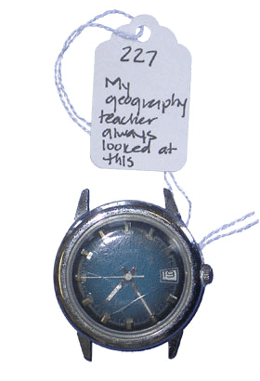
Watch number 227 of the Thousand Watch Project.
CURWOOD: “Time present and time past are both perhaps present in time future,” writes the poet TS Eliot – and an architectural firm in Boston couldn’t agree more.
They’re designing a preserve for an artifact that is rapidly becoming an anachronism – the wristwatch.
Living on Earth’s Bruce Gellerman has our story.
GELLERMAN: Boston based Moskow Linn Architects specialize in creating buildings for environmental organizations. No question business has been slow lately, but things perk up when its time to open the mail. Today partner Keith Moskow gives a visitor the honor.
MOSKOW: Why don’t you open that? We don’t know what’s in it.
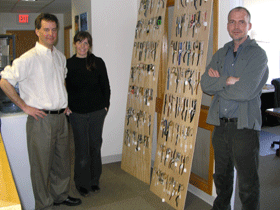
Keith Moskow, Sarah West, Robert Linn(left-right).
GELLERMAN: Well this is exciting.
MOSKOW: It is – it’s the excitement each day. What shows up in the mail.
[MORE OPENING SOUNDS]
GELLERMAN: Moskow Linn Architects receive a lot of packages these days: stacks of brown boxes and beige envelopes.
It comes with a little bubble wrap here.
[BUBBLE WRAP AND OPENING SOUNDS]
MOSKOW: Whoa.
GELLERMAN: Whoa.
MOSCOW: Whoa.
GELLERMAN: A trove! I think you’re over -
MOSKOW: A treasure trove!
GELLERMAN: Look at this
[WRINKLING OF PACKAGING]
GELLERMAN: Oh my gosh, somebody sent you – watches. Lots and lots of wristwatches.
Large and small, digital and analogue. Some with bands, some without. Each watch in this box has a small tag with a short, neatly written message which Keith Moskow reads.
MOSKOW: Cool purchase quickly became fashion don’t. I begged my grandma for this. I wore it only once. Katie.
[WRINKLING OF PACKAGING]
MOSKOW: She had a lot of watches here. [Laughing] Received at the age six but I couldn’t tell time.
[WRINKLING OF PACKAGING AND LAUGHING]
MOSKOW: I’m sure Katie uses her cell phone now.
[WRINKLING OF PACKAGING]
GELLERMAN: And so do many people. The times are a-changing and how we tell time is also changing.
MOSKOW: If you think about it, most people under the age of twenty-five do not where a wristwatch. They use their cell phone. And so arguably the wristwatch will go the same way as a pocket watch, so this is a moment in time, this changing, this time period when we’re switching over.
GELLERMAN: To preserve the past and mark the time when people wore wristwatches, Moskow Linn architects have created what they call the Thousand Watch Project.
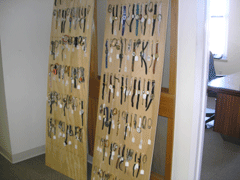
The watch collection thus far. (Photo Bruce Gellerman)
GELLERMAN: What does the Smithsonian say about this? Have you approached them yet?
MOSKOW: We have sent and inquiry letter as you do and we’re waiting to hear what they say. We’re sending it to them either way, anyway.
GELLERMAN: Then it’s their problem.
MOSKOW: Yeah
[LAUGHING]
MOSKOW: But we’re going to pack it up because it really becomes a time capsule.
GELLERMAN: The Thousand Watch Project began modestly with a notice on Craigslist, but clearly it’s an idea who’s time has come says architect Robert Linn.
LINN: Here’s something we’ve identified as kind of a cultural phenomenon, that people have all these watches, you can’t throw them away. Maybe its because you where them so close to your skin, maybe its because it’s the one item of clothing or object that you wear every single day for a short period of time. You then switch it out for another one. So it sort of marks different periods of time in people’s lives. So we didn’t know exactly what we were gonna do with them, but we just started collecting them to see where it would lead. And it turns out that that really resonated with a lot of people.
MOSKOW: It wasn’t something we sat down and said “Oh, we’re just gonna do it.”
GELLERMAN: Again, architect Keith Moskow.
MOSKOW: I found that I had watches in my drawer that I just couldn’t get rid of. I had gotten a watch for a graduation present from college twenty-five years ago.
GELLERMAN: Everybody did.
MOSKOW: A couple years later, it went through the washing machine. I never told my mother until literally a couple of weeks ago. But it moved with me half a dozen times, even though it was a busted watch. It’s inscribed in the back. I couldn’t toss it out. I’d purchased my first Swatch when I was in architecture school, I was in Switzerland. Once again, it turned yellow I wore it so long. It was a clear watch, couldn’t toss it out. And Rob and I were chatting one day and we realized that he had a bunch of watches too that he had never tossed out. So we go okay, well, let’s bring them to work, we’ll sort of get them out of the sock draw, put them somewhere else.

Reporter Bruce Gellerman’s old watch.
WEST: 470 was recent donation and the epitaph that was sent in with it said for Sergeant Rodney Murray, time just ran out. No other explanation was sent in.
MOSKOW: That’s very interesting because that watch came in, it was a fellow who used to work here, and he ran as a seeing-eye runner for someone in the New York marathon. He led somebody and he clicked it when he was done with his time – it was just over four hours.
GELLERMAN: Number 400.
WEST: Number 400 says, “You will always remind me of youth” from Shane Hughs. Yes, and this is one that was sent in from Australia.
GELLERMAN: This one. “You used to be my favorite. Not so much anymore.” These are like little gravestones, you know.
MOSKOW: They are. Well that’s the idea. It’s an epitaph, and it’s a way of just putting a couple of words. You only put a couple of words on a gravestone, and it’s just enough to tweak somebody’s imagination or memory.
GELLERMAN: So let me read a couple of these: “As time ran out, left in the second grade lost and found for two years.” Wisconsin.
MOSKOW: “Bought at our friend Cindy’s cancer fundraiser. RIP Cindy.”
GELLERMAN: So some of these really are from people who are no longer alive.
MOSKOW: Very well could be. I mean we’ve gotten watches from people who said they were parents’ and or grandparents’ watches and they just could not get rid of them. But here was an honorable way to – something honorable to do with it.
GELLERMAN: The watches are also photographed and Sarah West scans the picture onto the Thousand Watch Project website where they can be seen for all time.
WEST: I think it’s a nice bit that once they’re online, you can continue to visit it, you know as if you were opening the drawer, you remember it, you know, maybe, so you can still have a bit of that relationship, but I think people do entrust us to protect this memory and this keepsake and expect that we’ll treat it well. We try to.
GELLERMAN: Recently the Thousand Watch Project hit a milestone, the halfway mark. Architect Keith Moscow.
MOSCOW: This is number 500. And it says, “Treasure from the past. I love this watch. M.B.M.” Number 500. So this was a really important watch to receive.
GELLERMAN: Actually you guys are recycling time, you’re answering that age old question, what do you do with your old watch.
MOSCOW: And what do you do with your time?
GELLERMAN: Me? I sent two old watches in to the Thousand Watch Project, number 511 and 512.
For Living on Earth, I’m Bruce Gellerman.
[MUSIC: Easy All-Stars “Time” from Dub Side OF The Moon (Easy Star records 2003)]
CURWOOD: To check out the entire Thousand Watch Project collection and learn how you can donate your old watches, go to our web site: loe.org.
Related link:
The Thousand Watch Project website
YOUNG: On the next Living on Earth – big cities might have bright lights, but they don’t have accessible, healthy food.
KATE: I took two buses, or a car service, to get food back to Red Hook. I mean, you couldn’t even get a quart of milk or vegetables.
YOUNG: Efforts to plant some new seeds in food deserts. Next time on Living on Earth.
CURWOOD: Living on Earth is produced by the World Media Foundation. Our crew includes Bobby Bascomb, Eileen Bolinsky, Bruce Gellerman, Ingrid Lobet, Helen Palmer, Ike Sriskandarajah, and Mitra Taj, with help from Sarah Calkins and Marilyn Govoni.
YOUNG: Our interns are Lindsay Breslau, Liz Gross, Phil DiMartino and Christine Parrish. Jeff Turton is our technical director. Alison Lirish Dean composed our themes. You can find us anytime at loe.org.
I’m Jeff Young.
CURWOOD: And I’m Steve Curwood. Thanks for listening.
ANNOUNCER: Funding for Living on Earth comes from the National Science Foundation, supporting coverage of emerging science, and Stonyfield Farm: organic yogurt and smoothies. Stonyfield pays its farmers not to use artificial growth hormones on their cows. Details at stonyfield.com.
Support also comes from you our listeners, the Ford Foundation, the Town Creek Foundation, the Oak Foundation supporting coverage of climate change and marine issues; the Skoll Foundation, supporting social entrepreneurs around the world – uncommon heroes dedicated to the common good. Learn more at skoll.org; and Pax World Mutual Funds: socially and environmentally sustainable investing. Pax World: for tomorrow. On the web at paxworld.com.
ANNOUNCER: PRI, Public Radio International.
Living on Earth wants to hear from you!
Living on Earth
62 Calef Highway, Suite 212
Lee, NH 03861
Telephone: 617-287-4121
E-mail: comments@loe.org
Newsletter [Click here]
Donate to Living on Earth!
Living on Earth is an independent media program and relies entirely on contributions from listeners and institutions supporting public service. Please donate now to preserve an independent environmental voice.
NewsletterLiving on Earth offers a weekly delivery of the show's rundown to your mailbox. Sign up for our newsletter today!
 Sailors For The Sea: Be the change you want to sea.
Sailors For The Sea: Be the change you want to sea.
 The Grantham Foundation for the Protection of the Environment: Committed to protecting and improving the health of the global environment.
The Grantham Foundation for the Protection of the Environment: Committed to protecting and improving the health of the global environment.
 Contribute to Living on Earth and receive, as our gift to you, an archival print of one of Mark Seth Lender's extraordinary wildlife photographs. Follow the link to see Mark's current collection of photographs.
Contribute to Living on Earth and receive, as our gift to you, an archival print of one of Mark Seth Lender's extraordinary wildlife photographs. Follow the link to see Mark's current collection of photographs.
 Buy a signed copy of Mark Seth Lender's book Smeagull the Seagull & support Living on Earth
Buy a signed copy of Mark Seth Lender's book Smeagull the Seagull & support Living on Earth

